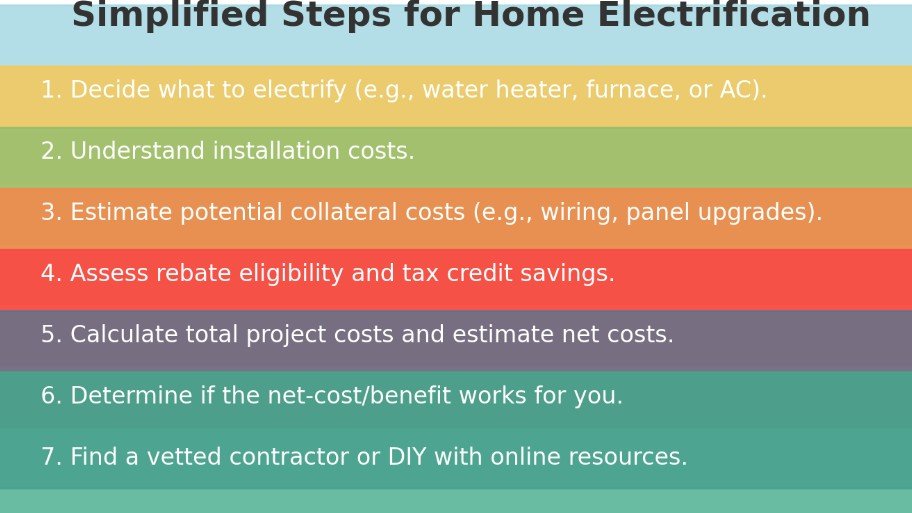Home Electrification: The Shifting Incentives Landscape and What To Know
Written by: Keith Nickolaus, CRBA Writers Team
As IRA (Inflation Reduction Act) funds get sequestered under DOGE and various executive orders, many of the building electrification incentives slated to roll out in California beginning in late 2024 and continuing into 2025 are now no more. That said, incentive hunters may still find some helpful resources that can make replacing old gas appliances with heat-pump solutions easier and more affordable. In this post, you’ll get a birds-eye-view of the shifting electrification incentives landscape in California and lots of tips and insights to guide you in planning your own home or building electrification projects.
Right before the Trump administration entered the White House, California residents were promised a new round of substantial rebates and credits as incentives for residential electrification, primarily in the form of heat-pump water heaters and heat-pump HVAC systems, to replace aging natural gas ones and to promote more energy-efficient air conditioning in hotter regions.
These incentives were initially open to multi-unit buildings in the late fall of 2024; single-family residences were to be eligible a bit later in 2025.
Now the landscape for residential and small business electrification rebates and incentives is rapidly shifting in California due to the political winds in Washington D.C.
In particular, California lawmakers are unable to access the federal dollars earmarked for funding incentive programs like those slated to roll out in California this year, such as the building electrification rebates and credits.
California Staying the Course on Building Electrification?
But, California’s electrification ambitions, while curtailed by the lack of federal support, are not simply dead on arrival. There is still a statewide blueprint for phasing out gas appliances — with heat-pump solutions playing a central role with regard to accelerating building decarbonization.
Also, heat-pump technology is now more widely available in the state, with more contractors equipped to help deploy these solutions and phase out appliances like:
Natural gas space heaters and furnaces
Natural gas water heaters
Less electricity-efficient air conditioning units
“Replacing your water heater with a HPWH today can save more than 2,000 pounds of CO2 emissions annually, according to NBI staff, and that’s the CO2 equivalent of growing more than 17 trees for 10 years, according to data from the U.S. Environmental Protection Agency (EPA). That equates to 12 tons of CO2 over the lifetime of the average water heater!”
Here’s a snapshot of the shifting incentives landscape:
A statewide legislative proposal under consideration: The proposal outlines a more streamlined permitting process for heat pump installations
Local Targets: Local air quality regulations passed by the Bay Area Air Quality Management District (BAAQMD) require Bay Area residents to start replacing their aging or broken natural-gas-fueled furnaces and water heaters with zero-emissions electric units starting in 2027
Curtailed Incentives: Very recently (March 2025), California put a $290 million home electrification rebate on hold due to blocked IRA funding
Existing State Dollars for Electrification Incentives: CA still has some $500 million for equity-focused incentives — electrification incentives for the low-income households
Other CA Incentives: Some statewide rebates are still in place for retrofitting gas water heaters with central heat-pump water heaters in small multifamily residential units
Regional Incentive Programs: Additional region-specific rebates from the state target the counties of San Luis Obispo, Santa Barbara, and Ventura
A Patchwork of Smaller Local Programs: Residents who search around will find a patchwork of smaller incentive programs specific to local communities, funded by local utilities or local public agencies, such as:
Local electrification rebates available to customers of Alameda Municipal Power for both single-family and multi-family units
Heat pump rebates for homeowners with multi-family or single-family units in the Bay Area Air District, pending eligibility approval
Resources for Navigating the Incentives Maze:
One-Stop Electrification Information Websites:
The Tech Clean California Website (one-stop California residential electrification news, information, and incentives website)
The Switch Is On Incentive Lookup Tool (tools for California and Washington) (A great platform for conducting filtered searches for incentives based on type and location)
Subscribe for email updates from Switch Is On California for another way to monitor incentive programs.
Additional Resources:
QuitCarbon (home electrification information, advising, and resources)
Zero Energy Project (home electrification information, advising, and resources)
Bay Area Regional Energy Network (bayren.org) (includes information about various home renovation incentive and rebate programs)
Marin County's Electrification Roadmap: A Step Toward a Greener Future!
Electrification in the Bay Area: Paving the Way to a Sustainable Future
Homes | Rewiring America (a site with information about electrification for homeowners and renters)
SPUR/Sierra Club/Rocky Mountain Institute — 2022 Building Electrification Policy Paper
Pros & Cons of Induction Cooktops and Ranges (Consumer Reports)
What Kinds of Incentives? What Kinds of Projects?
Incentives typically take the form of:
Rebates
Tax credits
Discounts on Equipment Purchases and/or Labor Costs
Most of the incentives are “after-the-fact” — meaning they are ways to recoup some dollars but usually only after you’ve paid the full costs upfront, and fully complete a project following all incentive-program guidelines and requirements.
BUT, if you’re looking for incentives for a project that’s already started or completed, that project will, in many cases, not be eligible.
Who is eligible to benefit? — Will vary from program to program, but can include both property owners and renters.
The kinds of property targeted vary…
Some incentives are specific to small business or multi-family residential units vs. single-family residential units.
It’s also important to keep in mind that incentives tend to come and go, and so going down this road requires some persistent vigilance and monitoring.
That said, here are the kinds of projects or appliances that typically qualify for incentives:
Replacing natural gas water heaters with heat pump water heaters (HPWH)
Replacing natural gas heat pumps with heat pumps for space heating and cooling (with duct system and/or mini-splits)
Replacing gas ranges with electric or induction ranges or stovetops
Upgrading/Retrofitting electrical panels
Improving home insulation
Other Factors That Frequently Impact Eligibility:
Some incentives include income restrictions (i.e., only low-income applicants will qualify).
Often projects already completed or underway are ineligible for incentives. So, you need to know about the incentive and plan accordingly, before the project is set in motion.
Incentives can take various forms and present various requirements. Common examples are rebates (processed after completion of a project); tax credits you can apply to your tax filing for the tax year the project was paid for; or discounts on equipment or installation costs.
Some incentive programs allow you to “layer” incentives, combine them with other incentives for increased benefits
Many incentive programs require that installation work be done by a qualifying, enrolled contractor
In light of all of this, it pays to do due diligence and ensure each component of your project plan and execution conform with incentive guidelines and requirements (and to know if you can afford the upfront costs).
Streamlining the Process With a (No-Cost) Building Electrification Consultant
One way to make finding and qualifying for incentives more manageable is by working with a specialized electrification consultant.
Some of these offer no-cost services to homeowners and small businesses too, making money through commissions from contractors, by connecting contractors to interested and eligible homeowners and their projects.
These advisors can help homeowners with what is (hopefully) disinterested advice on stuff likely to be overwhelming for homeowners, like:
Assessing your home’s current energy and appliance profile and the best solutions…
Understanding scope of work required and estimated costs…
Helping you find the right incentive programs for your specific projects and needs and feel confident about what’s worth paying for (and what isn’t)…
Connecting you with contractors with a positive track record, have the right skills for the project you need, and work in your area…
They help homeowners proceed with more confidence and understand if a project is feasible before trying to find and vet contractors, and then helping connect you to pre-vetted contractors based on the kind of project, scope of project, and location
Here are a couple of advising entities that help in these ways, but please understand the information here does not constitute any form of endorsement :
Electrification & Return on Investment??
Unless you’ve been living on another planet, you’re well aware that Bay Area electricity costs are quite high right now — kind of a big disincentive alongside other efforts to create incentives!
Without a good solar installation and solar contract to support a larger residential electricity footprint, you may find that even with some state or local incentives, your only return on investment will be feeling good about doing good at best – and even that may wear thin after you get gouged by PG&E for a few months…
On top of high PG&E electricity rates, there’s also lots of uncertainty about existing net-tariff residential solar contracts — contracts based on past incentives which PG&E and the CPUC are trying to renege on!
In short, there’s no one-size-fits all formula for a cost-benefit analysis, but the bottom line is that you REALLY need to do your due diligence before committing to any electrification project, because it could help the planet, but it could potentially be expensive — both the project itself, as well as any increased reliance on electricity in today’s rate environment.
Tell Us What YOU Think…
Please share what you think about building electrification as part of a larger roadmap to combatting global warming…
Do you have a residential electrification project that’s gone well (or gone south…)? Do you have advice for anyone thinking about their own electrification project?
Do you own heat-pump water heaters or space heaters, or an induction stove, or other energy- and carbon-saving appliances? What should readers know about them?
Have you taken advantage of any electrification incentives? Did you get the benefit you hoped for? Any insights to share from the experience?
Can you point readers to any other helpful resources that help people move forward with an electrification project?


